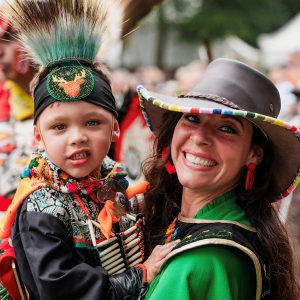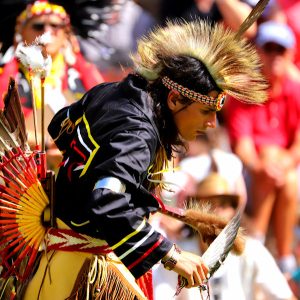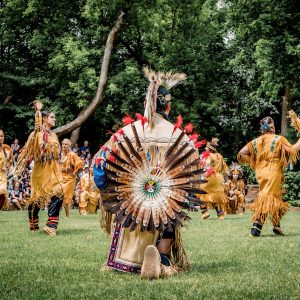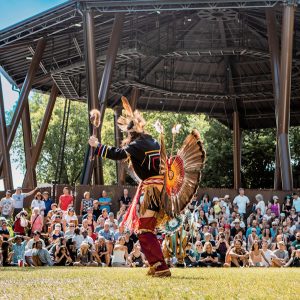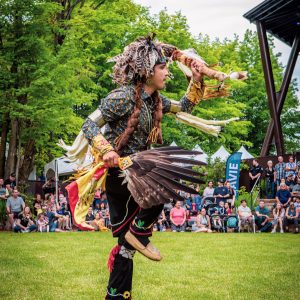The Grand Entry
During this opening dance, the flag bearers enter first. They are often war veterans and they carry the flags of the country. The chiefs, Elders and tribal leaders come second. Then the dancers enter the arena – the men first, followed by the women and, finally, the children. Because of the sacred character of this dance, spectators are asked not to take pictures during the Grand Entry.
The Drum
The drum is the heart of the pow-wow, the beat that all dancers move to. Some people say that the drum makes the sound of a heartbeat. It represents the heartbeat of our Mother-Earth that all dancers honour in every dance.
Men’s Traditional
The Men’s Traditional is one of the oldest dances in pow-wows. Each dancer portrays the warrior in him. It is a very important spiritual dance; it tells hunting and war stories about the dancers’ ancestors.
Men’s Grass Dance
Some people believe that the beginnings of the Grass Dance were when scouts would dance on fields of grass to flatten a place where they could set up camp. Today, the Grass Dance involves dancers stomping their feet in a way that looks like they are flattening out the grass on the field.
Men’s Fancy Dance
This dance was created in 1920s in Oklahoma as a form of entertainment for people visiting Aboriginal reservations. Today, it is one of the flashiest and most colourful of the pow-wow dances. It is usually performed by younger men as they must be in excellent physical condition because they are constantly jumping, twirling and performing fancy footwork. The dancers wear elaborate and colourful regalia.
Women’s Traditional
Throughout this noble dance, the dancers move in a slow and sedate walk, their feet always in contact with the ground, demonstrating a graceful and sacred connection with Mother Earth.
Women’s Fancy Shawl Dance
In the 50s, women were not allowed to dance in the dance circle. It was only after a woman disguised as a man entered the dance circle that women obtained the right to perform in the dance circle. Originally, they danced wearing their blanket but, gradually, they added long ribbons and embroidery. The dance involves kicks, spins and fast movement while the dancer holds the end of her shawl out so that it looks like she has butterfly wings.
Women’s Jingle Dress
According to an old legend, Maggie White, of Ojibwe country, fell very sick. As she was dying, and nobody knew how to cure her, her grandfather had a dream about a girl wearing a jingle dress. He told the elderly women of the village about his dream. They decided to make a dress and decorate it with the lids of snuff cans moulded into triangular shapes. The first day that Maggie wore the dress, she was able to sit up in her bed, the next one, she could walk and the third day, she could dance and had completely recovered. Nowadays, dancers are sometimes asked to dance to help heal sick people.
Today, jingle dresses must be made by hand over a period of one year. One jingle must be installed each day. A pouch with a little tobacco must be inserted in the jingle. At the end of the year, there will be 365 jingles on the dress. The jingle dress is a medicine dress. The dancer sends 365 prayers to the Creator during her dance.
Smoke Dance
On the pow wow circuit, amid more common dances such as the traditional dance and the grass dance, the Smoke Dance was sometimes performed as a special dance starting in the 1920s or ’30s. The Smoke Dance is originally a war dance that was only danced by men. The Smoke Dance as it is practiced today is a recent creation. Although it is not considered an Earth song (social song), it has recently grown in popularity thanks to Smoke Dance competitions. In recent decades, during Iroquois song and dance performances or exhibitions, certain singers have sped up the tempo of the old “war dances” to see if the dancers could keep up. This is how the “Smoke Dance” was born. During Smoke Dance competitions, the men sing both the new, faster war dances and the old, slower ones, while the women only dance to the faster songs.
The music and clothing are simple yet elegant. The music is provided by a solo singer and a single water drum, although some singers use a skin drum, which creates a deeper sound. The women’s clothing, fabric dresses decorated with pearls or appliques, is relatively plain, much like that of the men, who have no bust and often wear a feather headdress, or even a loincloth over a fabric top and pants, sometimes adorned with flat or raised beads.
These days, the Smoke Dance is strictly a show dance; it is a competition dance or a special dance that is usually not treated with the ceremony that it may once have had. As a show dance, it is magnificent: the fast rhythm encourages the dancers to cross the dance arena as if they were flying through the air. As with all dances, it is essential to end on the last drumbeat and stay with the rhythm.

